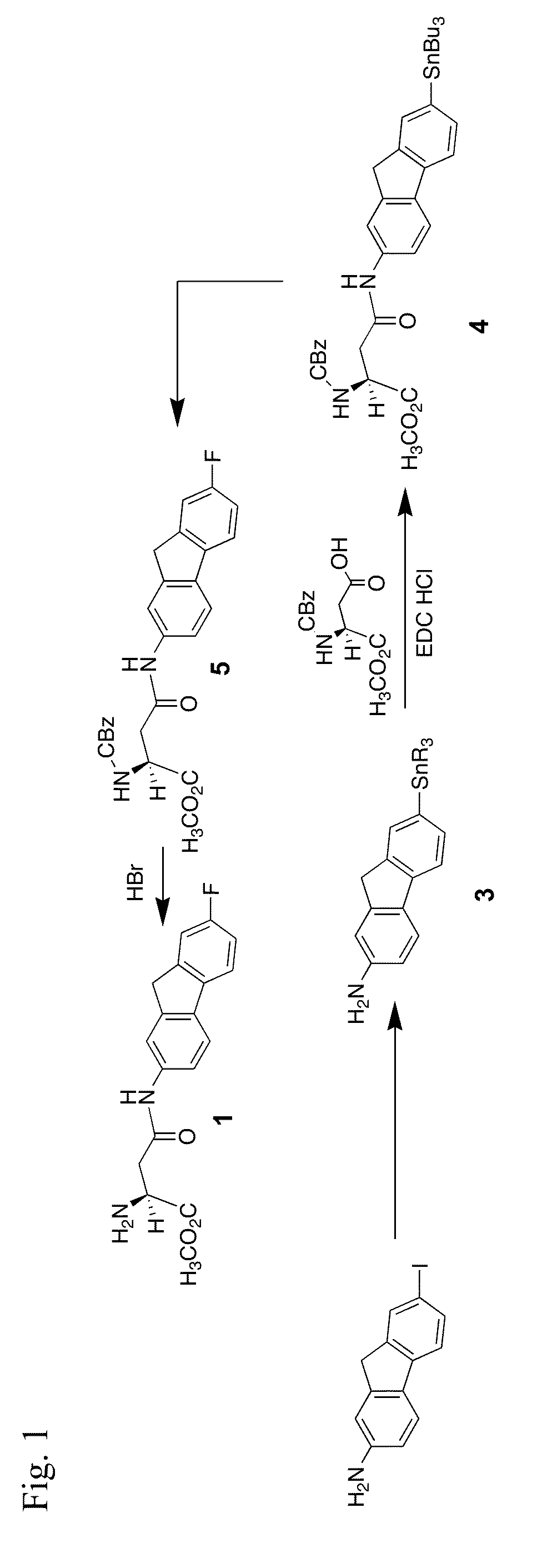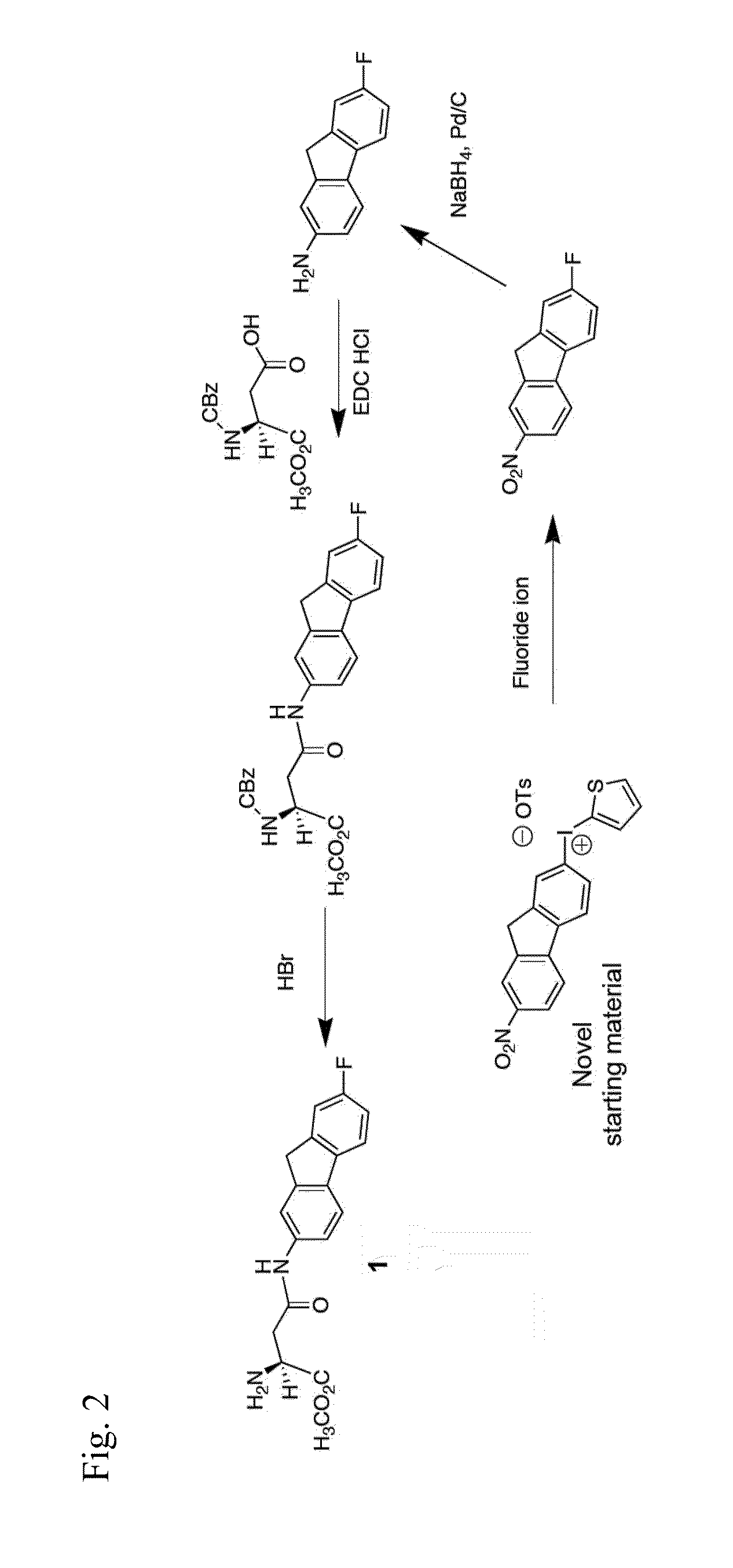Novel Aspartylamide Inhibitors of Excitatory Amino Acid Transporters
a technology inhibitors, which is applied in the direction of tin organic compounds, group 4/14 element organic compounds, acyclic/carbocyclic compounds, etc., can solve the problems of over-activation of excitatory amino acid receptors, neuronal pathology, cell death, energy consumption and increased rates of reactive oxygen species (ros) generation, etc., to achieve the effect of improving solubility and being convenient to administer
- Summary
- Abstract
- Description
- Claims
- Application Information
AI Technical Summary
Benefits of technology
Problems solved by technology
Method used
Image
Examples
examples
[0120]In a related aspect, therapeutic compositions having at least one novel compound of the invention described herein can be administered in combination with one or more additional agents for the treatment of any of the diseases, disorders, conditions, or symptoms described herein.
[0121]It is understood that the foregoing examples are merely illustrative of the present invention. Certain modifications of the articles and / or methods employed may be made and still achieve the objectives of the invention. Such modifications are contemplated as within the scope of the claimed invention.
example i
Synthesis of Compound 1
[0122]Compound 1 is prepared according to the synthetic routes shown in FIGS. 1 and 2. Each route uses a strategy of a regiospecific late-stage introduction of a fluorine atom onto a specific aromatic ring position of the fused fluorenyl ring system. A similar strategy has been used for the regiospecific introduction of a radioactive form of the fluorine atom at the same fluorenyl ring system position as described further below in the application.
[0123]FIG. 1 illustrates a third late-stage fluorine atom introduction synthesis of compound 1:
7-(Tributylstannyl)-9H-fluoren-2-amine, 3
[0124]A mixture of 7-iodo-9H-fluorene-2-amine (100 mg, 0.325 mmol), bis-tributyltin (0.32 mL, 0.65 mmol) and tetrakis(triphenylphosphine)palladium (37.55 mg, 0.032 mmol) was refluxed in dry dioxane at 100° C. for 3 h under argon. The mixture was cooled and then the volatiles were removed in vacuo. The residue was purified by preparative silica gel column chromatography (3:2, hexanes:...
example ii
Synthesis of Compound 6
[0129]Compound 6, an EAAT2 active parent agent, is prepared using the material derived in Example I (see above), according to the synthetic route shown in FIG. 3:
(S)-2-Amino-4-(7-fluoro-9H-fluoren-2-ylamino)-4-oxo-butanoic acid, 6
[0130]Compound 1 (7.91 mg, 0.024 mmol) was dissolved in a 0° C. solution of 1:1 tetrahydrofuran:water. The mixture was stirred at 0 ° C. for 30 min, then reaction was brought to pH 7 with 1M HCl1. The resultant solution was extracted with ethyl acetate, the organic portion was collected, washed with a saturated solution of sodium carbonate then brine. The organic portion was collected, dried over Na2SO4, filtered and the solvent was removed in vacuo. The resultant residue was recrystallized using a mixture of chloroform and diethyl ether, to afford 6 (4.69 mg, 62% yield) as a tan solid. 1H NMR (500 MHz, CDCl3+ CD3OD) δ8.17 (s, 1H), 7.87 (s, 1H), 7.75-7.70 (m, 1H), 7.52 (d, 1H, J=8.3 Hz), 7.30 (d, 1H, J=8.3 Hz), 7.10 (t, 1H, J=8.4 Hz),...
PUM
| Property | Measurement | Unit |
|---|---|---|
| time | aaaaa | aaaaa |
| pH | aaaaa | aaaaa |
| pH | aaaaa | aaaaa |
Abstract
Description
Claims
Application Information
 Login to View More
Login to View More - R&D
- Intellectual Property
- Life Sciences
- Materials
- Tech Scout
- Unparalleled Data Quality
- Higher Quality Content
- 60% Fewer Hallucinations
Browse by: Latest US Patents, China's latest patents, Technical Efficacy Thesaurus, Application Domain, Technology Topic, Popular Technical Reports.
© 2025 PatSnap. All rights reserved.Legal|Privacy policy|Modern Slavery Act Transparency Statement|Sitemap|About US| Contact US: help@patsnap.com



